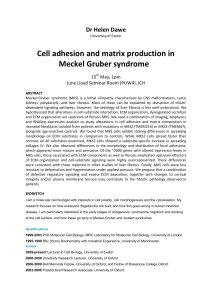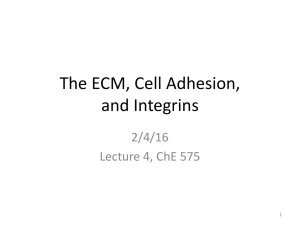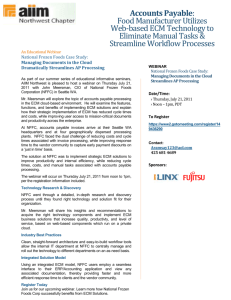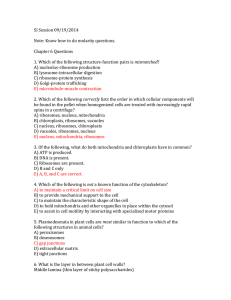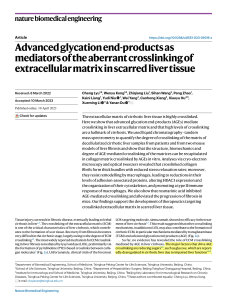Harvard-MIT Division of Health Sciences and Technology
advertisement
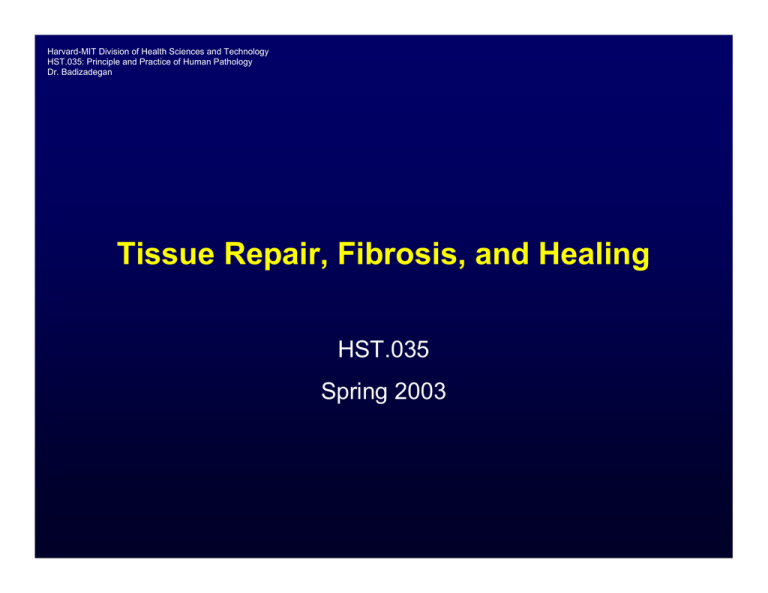
Harvard-MIT Division of Health Sciences and Technology HST.035: Principle and Practice of Human Pathology Dr. Badizadegan Tissue Repair, Fibrosis, and Healing HST.035 Spring 2003 Tissue Repair (Healing) • Regeneration of injured tissue (replacement by normal cells of the same kind) • Replacement by fibrous tissue (fibrosis, scarring) Normal Cell Proliferation Proliferating cells progress through a series of defined phases and checkpoint, collectively call the cell cycle Control of Cell Cycle • Progression through the cell cycle is controlled at specific checkpoints (restriction point in G1, mitosis entry and mitosis exit) • Transition between stages of mitosis is triggered by increased activity of cyclin-dependet kinases (CDK) • Each CDK modulates the activity of a subset of cellular targets specific for progression through individual transitions with the cell cycle Control of Cell Cycle Control of Cell Cycle CDK activity is controlled by constant synthesis and cyclic breakdown of specific cyclins Control of Cell Cycle • Cyclin-CDK complexes are also regulated by the binding of CDK-inhibitors • CDK-inhibitors are particularly critical at at G1 → S and G2 → M checkpoints, at which time adequacy and fidelity of DNA synthesis and replication are monitored • When DNA is found to be damaged, TP53 (p53) is stabilized and induces transcription of CDKN1A (p21), an inhibitor which arrests cells in G1 or G2 • If DNA damage is too extensive, TP53 will initiate apoptosis Cell growth and differentiation are dependent on extracellular signals from soluble polypeptide growth factors and the ECM Polypeptide Growth Factors • Soluble growth factors are transported either via the Gap junctions, or by autocrine, paracrine, endocrine, or synaptic transmission • For intracellular receptors, ligand binding leads to formation of complexes that directly associate with nuclear DNA and activate transcription • For cell surface receptors, ligands bind to a variety of receptor types that ultimately lead to activation of nuclear transcription factors Major Types of Cell Surface Receptors ECM: Interstitial Matrix and Basement Membrane Please see Kumar et al. Robbins Basic Pathology. 7th edition. WB Saunders 2003. ISBN: 0721692745. Biological Roles of the ECM • Mechanical support • Determination of cell polarity • Control of cell growth • Control/maintenance of cell differentiation • Scaffolding for tissue renewal • Establishment of tissue microenvironment • Storage and presentation of regulatory proteins Major Components of the ECM • Collagen • Elastic fibers • Proteoglycans and hyaluronan • Fibronectin • Laminin • Integrins Fibrillar Collagen: Tensile Strength Please see figures 5-17 and 5-18 of Junqueira & Carneiro. Basic Histology: Text and Atlas. 10th edition. McGraw Hill. 2003. ISBN: 0071378294. Collagen Fibrills Elastic Fibers: Stretch and Recoil Proteoglycans and Hyaluronan: Hydrated Gels Proteoglycans have a core of protein to which glycosaminoglycans are attached Glycoproteins are globular proteins with branched monosaccharide chains Proteoglycans such as syndecan can be transmembrane proteins with ligand binding capacity Fibronectin and Laminin • Fibronectin bind to a wide spectrum of ECM components and can attach to cell surface integrins • Laminin is a key glycoprotein in the basement membrane that binds underlying ECM components such as type IV collagen • Laminin also modulates cell survival, proliferation and differentiation Integrins link the ECM to Actin Cytoskeleton through Focal Adhesion Complexes ECM and Growth Control Repair by Connective Tissue (Fibrosis/Scarring) • Occurs when severe cell injury and damage to ECM framework precludes regeneration of native tissue • Fibrosis progresses through four main stages: – Angiogenesis – Migration and proliferation of fibroblasts – Deposition of ECM – Remodeling of ECM Fibrosis/Scarring Please see figure 3-10 of Kumar et al. Robbins Basic Pathology. 7th edition. WB Saunders 2003. ISBN: 0721692745. Overview of Tissue Response to Injury


